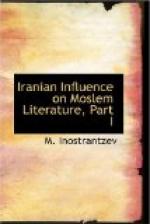7. The 7th title refers to the book of a certain mobedan mobed on rhetorical passages which were analogous probably to the anonymous Pand Namehs which are found in the Pahlavi literature.
8. The 8th is the book on the correspondence between the Kisra and a Marzban.[1]
[Footnote 1: Does not this appear like a book containing the correspondence on the well-known episode in the history of the Persians in Yemen and the letters which were exchanged between the Marzban or Mavazan and Khosrau Parviz? (See Noeldeke, Tabari 237, 264, 350-351).]
9-10. The 9th and the 10th titles relate to books of questions directed on a certain occasion by the king of Rome to Anushirwan and on another occasion by the king of Rome to another emperor of Persia.
11. The 11th book refers to the order of Ardeshir to bring out from the treasury books written by Wisemen on “Government.”
12. The 12th book was written for Hormaz, son of Kisra, i.e., Kisra Anushirwan on the correspondence between a certain Kisra and “Jamasp."[1]
[Footnote 1: Are we to understand under this name a reference to the well-known Jamasp Hakim occurring in Pahlavi literature (Weat, 110)?
On the Persian wisdom of Jamasp, see C.H.L. Flise, cher Kleinere Schriften 3 Leipzig, 1888, 254-255, and Justi Namenbuch, 109.
The name, however, cannot be clearly read, Hadahud (see Fihrist, 316, 13) where instead of Mardyud should be read Mardwaihi. In the same book 162, 6, instead of Zaydyud should be read Zaiduya. As regards the name Hadahud generally, see Justi, 177, who mentions a son of Farrukhzad.]
13. The 13th book is attributed to a certain Kisra and it is added that it treated of gratitude and was written for the benefit of the public.
14. Finally, the 14th heading referred no doubt to one of those Persian books written by Persians bearing Persian names and embodying various stories and anecdotes.
Of the remaining 30 books, 11 belong to the Moslem period but were composed at the time of complete Persian influence on Arabic literature. We have three books on Adab written for Khalif Mahdi, Rashid and for the Barmecide Yahya ibn Khalid. Then there are nine books by authors who are partly unknown and partly belong to the same period of Persian influence and who have been mentioned in other places in the Fihrist.
Of the remaining 19 books a considerable number is to be found to have issued from Persian sources. Of Persian origin probably were two books translated by the aforesaid Mihr Adur Jushnasp—one relating to ‘Adab’ and the other on ‘house-building.’
The book on the refutation of the Zendiks by an unknown author was probably derived from Parsi circles. For, especially in the reign of Mamun there existed various controversies with the followers of Mazdaism and Dualists.[1]
[Footnote 1: A. Barthelemy, Gujastak Abalish. Relation d’une Conference Theologique, presidee par le Calife Mamoun, Paris, 1887. (Bibliotheque de l’ecole des hautes etudes, sciences philologiques et historiques, LXIX., fascicule.)]




